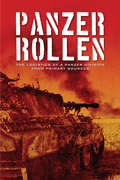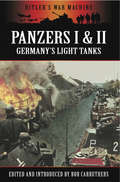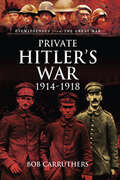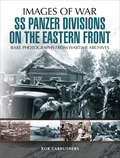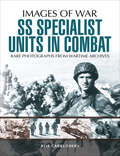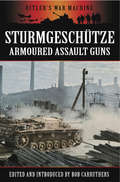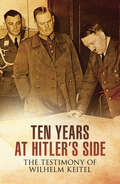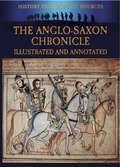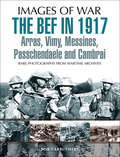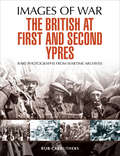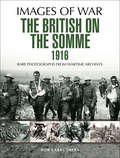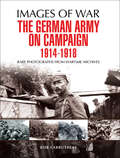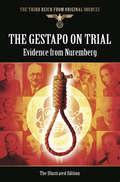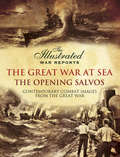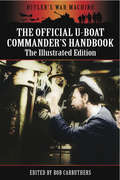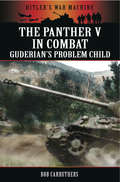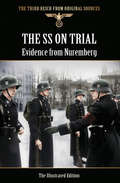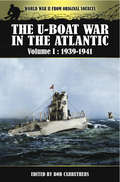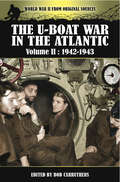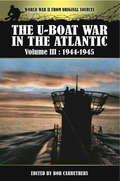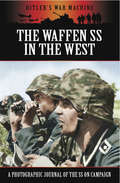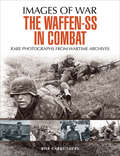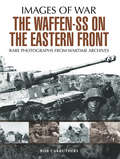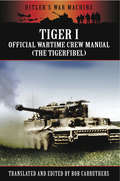- Table View
- List View
Panzer Rollen: The Logistics of a Panzer Division From Primary Sources
by Bob CarruthersPanzer Rollen provides an insightful look in to the workings of the Military Intelligence Service that was so invaluable in shaping both the strategy and tactics of the Allied forces during the Second World War.
Panzers I & II: Germany's Light Tanks (Hitler's War Machine)
by Bob CarruthersThe first vehicle to be produced in any numbers for the Panzerwaffe was the tiny Panzer I known as the MG Panzerwagen. Almost from the outset the limitations of the design for the Panzer I were obvious. It was essentially a training vehicle which was only pressed into service as a last resort. It was to be succeeded by the Panzer II which could at least engage armoured cars and combat against tanks with approximately the same armour as itself.Together these two tanks formed the bulk of the armour which between 1939 and 1941 conquered half of Europe.This comprehensive overview of the light Panzers in action was compiled by Emmy Award winning historian Bob Carruthers. It draws heavily on war-time intelligence reports to produce a fascinating insight into the development and combat history of the light Panzers at the tactical and operational level.Also featured are rare developments such as the Panzer II flame thrower variant alongside unpublished photographs and illustrations which provide an absorbing study, from an array of primary sources, of the world of the light Panzer and their crews from contemporary Allied sources.
Private Hitler's War, 1914–1918: 1914-1919 (Eyewitnesses from The Great War)
by Bob CarruthersDuring the Great War Adolf Hitler served in the ranks of the 16th Bavarian Reserve Infantry Regiment from 1914 to 1918, and was awarded the Iron Cross. In later years, under the masterful control of Doctor Goebbels, Hitler was successfully portrayed by the Nazis as a valiant front-line soldier who, for four long years, had fought many hard battles in the front-line of trenches.The world has long accepted the Nazi version, and Hitler is often referred to as a Corporal, but a series of clues remained which pointed to an alternative version of the truth. Even at the zenith of his power, Hitler was always mindful that there were those who maintained that, far from being a brave front-line fighter, he was actually a fraud; a draft-dodger and rear area malingerer who in four years of war had only ever fought in one action.Hitler knew the uncomfortable truth. The Nazi machine acted ruthlessly and former colleagues such as Hans Mend, who didn't toe the party line, soon ended up in concentration camps.Now, almost a century later, as a result of a series of painstaking investigations, the producers of the ground-breaking documentary Private Hitler's War have resolved the century long controversy over Hitler's service in the Great War. This powerful documentary tie-in book finally turns the Nazi myth on its head and reveals the full unvarnished truth concerning Adolf Hitler's actions in the Great War.
SS Panzer Divisions on the Eastern Front: Rare Photographs From Wartime Archives (Images of War)
by Bob Carruthers“This book is chock full of striking photographs taken throughout the war, from the invasion of Poland, to the last battles in Hungary . . . a treasure.” —Western Slope Division This book follows the path of the 1st SS Panzer Division “Leibstandarte SS Adolf Hitler,” 2nd SS Panzer Division “Das Reich,” 3rd SS Panzer Division “Totenkopf,” and 5th SS Panzer Division “Wiking” from the opening stages of the war and the challenges of Barbarossa, through to the long and bloody retreat to Berlin. This exceptional collection of images captures the titanic struggle endured by these divisions, and the chain of events they set in motion that proved so critical in shaping the face of the Second World War.Featuring rare images, this is the definitive record of SS Panzer Divisions on the Eastern Front, and an essential addition to any enthusiast’s collection.
SS Specialist Units in Combat (Images of War)
by Bob CarruthersIt is an often overlooked fact that the SS Divisions included Cavalrymen, Paratroopers, Mountain and Ski Battalions and these rare photographs illustrate the unique role played by specialist units in action.
Sturmgeschütze: Armoured Assault Guns (Hitler's War Machine)
by Bob CarruthersAn overview of the Wehrmacht&’s little-known mobile assault guns designed to provide close infantry support against enemy field defenses in World War II. The Stürmgeschutze rumbling forward into action is one of the iconic images of World War II. As mobile assault guns, the StuGs were essentially designed as infantry support weapons, but they also proved themselves as highly effective tank destroyers. Written by Emmy Award-winning author Bob Carruthers this fascinating study encompasses the design, development and combat history of the StuG II and IV. Drawing on a variety of rare primary sources and photographs this outstanding study explains the role of the StuG in context and examines the combat records of the StuG aces such as Franz von Malachowski, and Knight&’s Cross holder Oberwachtmeister Hugo Primozic of Stug.Abt.667. Indispensable reading for anyone with an interest in armored warfare, this book is part of the Hitler&’s War Machine series, a new military history range compiled and edited by Emmy Award winning-author and historian Bob Carruthers. The series draws on primary sources and contemporary documents to provide a new insight into the true nature of Hitler&’s Wehrmacht.
Ten Years at Hitler's Side: The Testimony of Wilhelm Keitel
by Bob CarruthersIn October 1946, Wilhelm Keitel was executed by hanging after being sentenced to death at the Nuremburg Trials. His road to this point was a long and controversial one, from the heady days of the surrender of France, to the eventual fall of Berlin and his subsequent arrest. There were few men better positioned to provide insight in to the minds and workings of the National Socialist Party, and of those a preciously limited amount were held accountable for their crimes. This renders the record of Keitels trial as published here an invaluable historical record that goes some way to providing an understanding of the near incomprehensible crimes committed during the Third Reich.Edited and introduced by esteemed historian Bob Carruthers, this unadulterated record of Wilhelm Keitels trial at Nuremburg is essential reading for all history enthusiasts and an important account of events that truly shook the world.
The Anglo-Saxon Chronicle: Illustrated and Annotated (History From Primary Sources Ser.)
by Bob CarruthersThe essential primary-source history of the British Isles through the early Middle Ages, fully annotated and illustrated with paintings and engravings. The Anglo-Saxon Chronicle is one of the most important sets of historical documents concerning the history of the British Isles. These vital accounts, thought to be first set down in the late ninth century by a scribe in Wessex, illuminate events through the Dark Ages that would otherwise be lost to history. Without this chronicle, it would be impossible to write the history of the English from the Romans to the Norman Conquest. The compilers of this chronicle included contemporary events they themselves witnessed, as well as those recorded by earlier annalists whose work is in many cases preserved nowhere else. With nine known versions of the Chronicle in existence, this translated edition presents a conflation of passages from different versions. Relying heavily on Rev. James Ingram&’s 1828 translation, the footnotes provided are all those of Rev. Ingram. This edition also includes the complete Parker Manuscript.
The BEF in 1917: Arras, Vimy, Messines, Passchendaele and Cambrai (Images of War)
by Bob CarruthersThis new volume in the long-running Images of War series features the actions of the British Army at Passchendaele. The book is comprised of rare photographs illustrating the years of fighting on the northern sector of the Ypres salient, which finally culminated in the capture of the ridge at Passchendaele, accompanied by a powerful text written by Official War Correspondent Philip Gibbs, who was an eyewitness to the events. Photographs from the battlefield illustrate the terrible conditions, which the British forces on the battlefield endured in the notorious engagement, which has become synonymous with mud and squalor.This book incorporates a wide range of images, encompassing the actions of the British infantry and their supporting artillery. Also featured are images which depict the almost incomprehensible state of the waterlogged trenches. Portraits of the British troops are contrasted with German prisoners of war and the endless battle to get the supply columns through to the front.
The British at First and Second Ypres: Rare Photographs From Wartime Archives (Images of War)
by Bob CarruthersThis new volume in the long-running Images of War series features the actions of the British Army at Ypres from 1914-15. Rare photographs illustrating the optimistic men of the BEF in the act of mobilization and transport to France are contrasted with photographs from the battlefield during the opening phases of the campaign, which culminated in the four-year struggle for the Ypres salient. The photographs are accompanied by a fascinating text, featuring Bruce Bairnsfather's personal description of the conditions endured by the men in the rudimentary trenches on the Ypres salient during 1914-15 as the early phase of the battle for Ypres raged around them. This book incorporates a wide range of photographic images encompassing the actions of the cavalry, infantry and artillery. Also featured are images, which depict the myriad activity behind the lines, dealing with German prisoners of war, the endless supply columns of the commissariat and the extraordinary efforts to provide proper medical care for the wounded.
The British on the Somme 1916: Memoirs From The Trenches 1916-1918 (Images of War)
by Bob CarruthersThis new volume in the long-running Images of War series features the actions of the British Army on the Somme. Not only is the book comprised of rare photographs illustrating the actions of the British army fighting on the Somme, but it is accompanied by a powerful text written by Official War Correspondent Philip Gibbs, who was an eyewitness to the events. Photographs from the battlefield illustrate the terrible conditions, which the British forces on the battlefield endured in the notorious engagement, which has become synonymous with vainglorious sacrifice.This book incorporates a wide range of images encompassing the actions of the British infantry and their supporting artillery. Also featured are images, which depict the almost incomprehensible reality of landscape, which characterized the war in the trenches. Portraits of the British troops are contrasted with German prisoners of war and the endless battle to get the supply columns through to the front.
The German Army on Campaign, 1914–1918: Rare Photographs From Wartime Archives (Images of War)
by Bob CarruthersThis is the photographic history of the German Army on campaign throughout the First World War. The most striking images from the German perspective are gathered here and form a significant historical record of one of the most important events of modern history.In 1914, the German war machine began its advance into Europe. By 1918 the German Army had lost over two million men, and suffered through some of the most horrific events in human memory. In a war caused by politics, it was the ordinary men who lost their lives and here we aim to highlight the human cost of the conflict from beginning to end.
The Gestapo on Trial: Evidence from Nuremberg (The Third Reich From Original Sources)
by Bob CarruthersThe Nuremberg Trials were held by the four victorious Allied forces of Great Britain, the USA, France and the USSR in the Palace of Justice, Nuremberg from November 1945 to October 1946. Famous for prosecuting the major German war criminals, they also tried the various groups and organisations that were at the heart of Nazi Germany.This fascinating volume is concerned with the trial of the Gestapo and includes all the testimony from the Nuremberg Trials regarding this organisation, including the original indictment, the criminal case put forward for the Gestapo, the closing speeches by the prosecution and defence and the final judgment. The book also includes evidence regarding the S.D. and the defendant Ernst Kaltenbrunner, who was Obergruppenfhrer and General der Polizei und Waffen-SS.The witnesses called for the trial of the Gestapo and the SD include among others, Karl Hoffmann who was head of the Gestapo in Denmark; Dr. Werner Best, head of Department 1 of the Gestapo, who was relied on by Himmler and Heydrich to develop the legalities of their actions against the enemies of the state and the Jewish problem; Rolf-Heinz Hoeppner, who was responsible for the deportation of Jews and Poles and the settlement of ethnic Germans in Wartheland; and Dieter Wisliceny who participated in the ghettoisation and liquidation of many Jewish communities in Greece, Hungary and Slovakia
The Great War at Sea - The Opening Salvos: Contemporary Combat Images from the Great War (The Illustrated War Reports)
by Bob CarruthersThis powerful collection, depicting the events of the Great War at sea, showcases the work of the contemporary combat artists and illustrators from the Great War era. The result is a stunning and vivid graphic record of life and death on the high-seas from 1914-18, as reported to contemporary audiences at a time when the events of the Great War were still unfolding. During the Great War artists and illustrators produced a highly accurate visual record of the fleeting moments the bulky cameras couldn't reproduce. These works form a body ofwar reportage that are as valid as the written word. Today, the work of the combat illustrators and the official war artists from the Great War era is overlooked by historians in favour of photographs, but these illustrations are nonetheless important, as they provide a contemporary record of hand-to-hand fighting, trench raids, aerial dogfights, sea battles, desperate last stands, night actions and cavalry charges.
The Official U-Boat Commanders Handbook: The Illustrated Edition (Hitler's War Machine)
by Bob CarruthersThis is the complete wartime translation by the U.S. Navy of the 1943 edition of the official handbook given to all U-boat commanders. The original handbook was compiled from combat reports and was regularly updated throughout the war. The handbook was an invaluable reference for every operational U-boat commander. Simply written and highly accessible for a wider audience, the U-boat handbook attempted to anticipate every possible situation and to advise on suitable tactics. This superb war-time primary source is enhanced by a rare series of photographs taken on an actual combat patrol and published during the time of the Third Reich in the book U-Boot Auf Feindfahrt.Together the handbook and these rare photographs provide a fascinating glimpse into the world of the U-boats from a first hand perspective, and is essential reading for anyone interested in World War II from primary sources.
The Panther V in Combat: Guderian's Problem Child (Hitler's War Machine)
by Bob CarruthersThe Panther V evidenced a number of problems in combat, and this was the proof of the rushed development programme thatwas made obvious from the events at Kursk. However, despite its disappointing battlefield debut, the Panther is frequently hailed as the best all round tank of the war.This fascinating study by Emmy award winning author and historian Bob Carruthers draws on a wide variety of combat reports and unique primary sources to weigh up the facts in order to produce the definitive single volume overview of a legendary fighting machine. Included are numerous examples of wartime combat reports from both Allied and German sources,additionally there are a large selection of extracts from the Pantherfibel, theoriginal crew training manual.This superb book is essential reading for anyone interested in tank warfare during World War II.
The SS on Trial: Evidence from Nuremberg (The\third Reich From Original Sources Ser.)
by Bob CarruthersAn Emmy Award–winning author reveals the complete testimony of the most infamous war crimes trials in human history following WWII—includes photographs. After the defeat of Nazi Germany, the Nuremberg Trials were conducted by the four victorious Allied forces of Great Britain, the United States, France, and the Soviet Union. They were held in the Palace of Justice, Nuremberg, Germany, from November 1945 to October 1946. Famous for prosecuting the major German war criminals, they also tried the various groups and organizations that were at the heart of Nazi Germany. Part of the illustrated series The Third Reich from Original Sources, The SS on Trial presents the complete testimony from the hearings, including the original indictment, the criminal case put forward for the SS, the closing speeches by the prosecution and defense, and the final judgment. Former SS members often wondered why they were charged as war criminals when they merely performed their &“normal&” duty. The Military Tribunal at Nuremberg attempted to answer that question. The witnesses called include Friedrich Karl von Eberstein, an early member of the Nazi Party, the SA, and the SS; Paul Hausser, one of the most eminent leaders of the Waffen-SS who vehemently defended their military role in the war; Georg Konrad Morgen, a former SS judge; and Wolfram Sievers, the Reich manager of the Ahnenerbe. Featuring forty photographs and charts, this indispensable volume explores how the actions of Nazi soldiers challenged humanity&’s notions of criminality and global justice.
The U-Boat War in the Atlantic, 1939–1941: Volume I: 1939- 1941 (World War Ii From Original Sources Ser.)
by Bob CarruthersFirst in the trilogy that covers WWII submarine warfare in the Atlantic from the German perspective—edited by the Emmy Award-winning historian and author. The U-Boat war is a unique visual record of Hitler&’s infamous submarine fleet and a grim account of those that lived, worked and risked their lives stalking the depths of the Atlantic and Mediterranean seas. This book analyzes the development of the U-boat, the recruitment and training, and reveals how the crews tried to destroy essential Allied supplies across the Atlantic and bring Britain to its knees. Using some 250 rare and unpublished photographs together with detailed captions and accompanying text, the book provides an outstanding insight into the various operations and the claustrophobic existence of the crew, where they lived in cramped and often deplorable conditions. It depicts how this potent force became one of the most dominant German fighting units during World War Two and became such a worry to Allied shipping that even Winston Churchill himself claimed that the &“U-boat peril&” was the only thing that ever really frightened him during the war. On their defeat hung the outcome of the war, and through courageous and determined resistance against overwhelming odds, the Allies eventually inflicted such catastrophic damage on the U-boats that the losses were too great to continue. Of the 38,000 men that went to sea onboard these deadly vessels, only 8,000 were to survive to tell the tale.
The U-Boat War in the Atlantic, 1942–1943: Volume Ii: 1942-1943 (World War Ii From Original Sources Ser.)
by Bob CarruthersThis is the fascinating account, as told from the German perspective, of the Battle of the Atlantic, the longest-running, continuous military campaign in World War II, spanning from 1939 through to Germanys defeat in 1945. At its core was the Allied naval blockade of Germany, which was announced the day after the declaration of war, although it quickly grew to include Germany's counter-blockade. The name "Battle of the Atlantic", was coined by Winston Churchill in 1941 and he famously stated that the U-boats were the only thing that really frightened him. The U-boat war encompassed a campaign that began on the first day of the European war and lasted for six years, involved thousands of ships and stretched over thousands of square miles of ocean, in more than 100 convoy battles and perhaps 1,000 single-ship encounters. In the 68 months of World War II, 2,775 Allied merchant ships were sunk for the loss of 781 U-boats.This is the story of that massive encounter from the German perspective. Published in three volumes, this work was compiled under the supervision of the U.S Navy Department and the British Admiralty by Fregattenkapitan Gunther Hessler. The author, though without previous experience as a writer, had first hand experience of U-boat warfare having commanded a U-boat in 1940 and 1941. For the remainder of the war he was Staff Officer to the Flag Officer commanding U-boats. He had access to German war diaries and other relevant documents concerning U-boat command, and this work based on these many documents, tells the story entirely from the viewpoint of that command. For this reason this work is essential reading for anyone interested in the history of World War II from primary sources and will be of enduring interest to those engaged in attempting to unravel the true nature of submarine warfare in World War II.
The U-Boat War in the Atlantic, 1944–1945: Volume Iii: 1944-1945 (World War Ii From Original Sources Ser.)
by Bob CarruthersThis is the second of three volumes covering the U-boat campaign in the Atlantic during the Second World War.This is the fascinating account, as told from the German perspective, of the Battle of the Atlantic, the longest-running, continuous military campaign in World War II, spanning from 1939 through to Germany's defeat in 1945. At its core was the Allied naval blockade of Germany, which was announced the day after the declaration of war, although it quickly grew to include Germany's counter-blockade. The name "Battle of the Atlantic", was coined by Winston Churchill in 1941 and he famously stated that the U-boats were the only thing that really frightened him. The U-boat war encompassed a campaign that began on the first day of the European war and lasted for six years, involved thousands of ships and stretched over thousands of square miles of ocean, in more than 100 convoy battles and perhaps 1,000 single-ship encounters. In the 68 months of World War II, 2,775 Allied merchant ships were sunk for the loss of 781 U-boats.This is the story of that massive encounter from the German perspective. Published in three volumes, this work was compiled under the supervision of the U.S Navy Department and the British Admiralty by Fregattenkapitan Gunther Hessler. The author, though without previous experience as a writer, had first hand experience of U-boat warfare having commanded a U-boat in 1940 and 1941. For the remainder of the war he was Staff Officer to the Flag Officer commanding U-boats. He had access to German war diaries and other relevant documents concerning U-boat command, and this work based on these many documents, tells the story entirely from the viewpoint of that command. For this reason this work is essential reading for anyone interested in the history of World War II from primary sources and will be of enduring interest to those engaged in attempting to unravel the true nature of submarine warfare in World War II.
The Waffen SS in the West: A Photographic Journal of the SS on Campaign (Hitler's War Machine)
by Bob CarruthersThis photographic journal was originally published in the spring of 1941. It was edited by and carried a forward by Hauptsturmfhrer Gunter d'Alquen, commander of the SS Propaganda Kompanie and editor of the official SS paper, Das Schwarze Korps.Many of the pictures taken in this book feature the men of Waffen SS Standarte "Germania". In 1940 the men who bore the word Germania on their cuff bands were fighting as a motorised regiment under the command of SS-Standartenfhrer Karl-Maria Demelhuber.This is a unique account of the Waffen SS on campaign in the west from a primary source, edited by, and with an introduction by Emmy award winning author Bob Carruthers.
The Waffen-SS in Combat: Rare Photographs From Wartime Archives (Images of War)
by Bob Carruthers&“A photographic history of some of the most elite of Germany&’s armed forces as they fought on all fronts during World War II . . . Highly recommended.&”—Scale Military Modeller This is the photographic history of the Waffen-SS in combat on all fronts. The short six-year history of the Waffen-SS spanned triumph and disaster, and their story can be traced through these powerful images, which clearly document the reality of combat from 1940 to 1945. These rare images span the combat history of the Waffen-SS from the optimism of the opening phases of the war in the west through to the challenges of Barbarossa and the long and bloody retreat against a numerically far superior enemy in both the east and the west. The powerful photographic record is essential reading for anyone with an interest in the course of the war from the German perspective and clearly demonstrated the scale of the task undertaken by the Waffen-SS on all fronts. &“This collection of b&w historical photos from WWII showcases photos taken by the Germans for propaganda purposes and published in newspapers, magazines, and books between 1940 and 1945. Many of the photos come from the SS-Kriegsberichter-Kompanie (Waffen-SS War Reporters Company), led by Gunter d&’Alquen, which recorded actions of platoons. The photos are grouped in three sections on the activities of the Waffen-SS in the west in 1940, in the east in 1941-1943, and in combat and defeat 1943-1945. Each section begins with an introduction giving context on the origins of the photos and the photographers and crews involved. There is also background on the units, platoons, and divisions photographed.&”—ProtoView
The Waffen-SS on the Eastern Front: A Photographic Record of the Waffen SS in the East (Images of War)
by Bob CarruthersA photographic history of the notorious Nazi fighting force during Operation Barbarossa—from the Emmy Award-winning historian and author. This is the illustrated history of the Waffen-SS—the armed political wing that grew out of the Schutzstaffel or Nazi party protection squads—on the Eastern Front. The life and death of the Waffen-SS can be traced in the surviving photographs, and the brooding saga of the decline from triumph into disaster is told through these powerful images which clearly document the reality of combat on the Russian Front.
Tiger I: The Official Wartime Crew Manual (Hitler's War Machine)
by Bob CarruthersThe original how-to manual for handling the German tank in World War II, edited and translated by the Emmy Award-winning historian and author. During the Second World War, Tiger tank crews had to be trained as quickly and effectively as possible. To assist in this process General Heinz Guderian authorized the publication of the Tigerfibel, the illustrated manual which was issued to Tiger I crews from 1943 onwards. This highly unorthodox publication was full of risqué drawings and humorous illustrations and was designed to convey complex battlefield instructions in a simple and memorable manner. This unique primary source has now been translated into English by Emmy Award-winning historian Bob Carruthers and published with a new overview and introduction. It makes for indispensable reading for anyone interested in tank warfare in World War II. The manual contains everything the reader could ever wish to know concerning how the crews were instructed to handle the Tiger I under combat conditions, including detailed instructions on aiming, firing, ammunition and close combat. There are extensive sections on maintenance, driving, radio operation and the essentials of commanding the heavy tank. This priceless information is now being made available to a wider English-speaking audience as an electronic publication for the first time. Fascinating and highly accessible, the Tigerfibel is essential and rewarding reading for all those interested in the history of this famous tank. This book is part of the Hitler&’s War Machine series which draws on primary sources and contemporary documents to provide a new insight into the true nature of Hitler&’s Wehrmacht.
Trench Warfare: Contemporary Combat Images from the Great War (The Illustrated War Reports)
by Bob CarruthersThis powerful collection, depicting the grim events of trench warfare, showcases the work of the contemporary combat artists and illustrators from the Great War era. Included here are the works of serious artists, propagandists, illustrators and humorists. The result is a stunning and vivid graphic record of life and death in the trenches during the Great War, as reported to contemporary audiences at a time when the events of the Great War were still unfolding. During the Great War artists and illustrators produced a highly accurate visual record of the fleeting moments the bulky cameras couldnt reproduce. These works form a body ofwar reportage that are as valid as the written word. Today, the work of the combat illustrators and the official war artists from the Great War era is overlooked by historians in favor of photographs, but these illustrations are nonetheless important, as they provide a contemporary record of hand-to-hand fighting, trench raids, aerial dogfights, sea battles, desperate last stands, night actions and cavalry charges.
